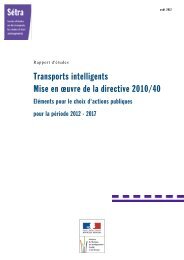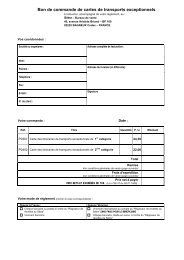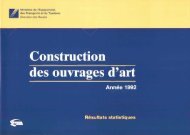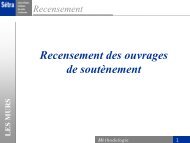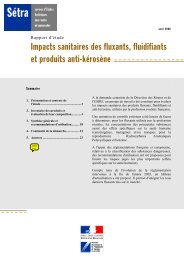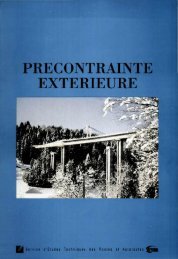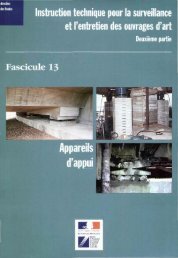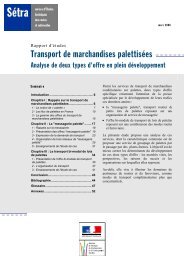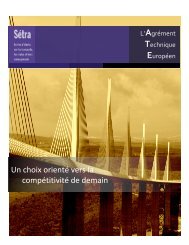ROUTIÃRES - Sétra
ROUTIÃRES - Sétra
ROUTIÃRES - Sétra
You also want an ePaper? Increase the reach of your titles
YUMPU automatically turns print PDFs into web optimized ePapers that Google loves.
Sétraservice d’Étudestechniquesdes routeset autoroutesTECHNIQUESROUTIÈRESENVIRONMENT TECHNICITY SAFETY EXCHANGES STANDARDISATION TRAVEL HERITAGEA global approach for anenvironmentally-friendlymotorwayA global approach for an environmentally-friendly motorwayTransport plays a determining rolein a whole series of stakes in oursociety, because of its effects on theenvironment and theeconomic and social developmentof the areas it uses and serves, thuseven requiring political managementwhich is the only way ofintegrating all these stakes. Thisinvolves the notion ofsustainable development.Transport policies, designing andplanning transport networks andsystems that combine complementarymodes of transport, butalso designing each infrastructure,must also meet sustainable developmentaims.There are four initial categories ofsustainable development stakes forany transport system or infrastructure:· environmental and heritagestakes: maintaining and preservingbiodiversity (fauna and flora); preservingsites and landscapes,archeological sites, historical andarchitectural heritage buildings,tourist appeal; preserving naturalresources (impact on energyreserves, drinking water reserves,Sustainabledevelopment,a transverseapproachforests, material resources, etc.)and streams; preserving agriculturalheritage;■ economic and social stakes:dynamic local development, (jobs(attractivity, accessibility), touristactivities); regional planning andsocial and economic equilibrium;the value of land and real estateclose to transport infrastructuresand serviced areas; waste recoveryand recycling, etc.;■ anitary stakes: quality of soil,plants and water on which infrastructureshave had an impact andreducing risks for the food chain;health of people involved in transportsystems (negative (air, noise),but also positive impacts, notablydue to gaining health care access);■ enjeux sanitaires : qualité des sols,des végétaux et des eaux impactéspar les infrastructures et réductiondes risques concernant la chaînealimentaire ; santé des populationsconcernées par les systèmes detransports (impacts négatifs (air,bruit), mais aussi positifs, notammentdu fait de l’accessibilité auxsoins) ;■ esocial-political stakes: informingand listening to involved peopleand participants, public debatesand dialogue, preserving socialcohesion, changing lifestyles, etc.In this respect, the actual design oftransport networks and infrastructures(type of traffic, layout ofinfrastructures and routes, avoidingsensitive or fragile areas, newaccessibility, technical design suitedto environmental stakes) willbe a determining factor in theirenvironmental quality, but alsomore generally for sustainabledevelopment. Their operationmode will also be essential:controlling traffic and speed,managing peak times and nightschedules (railway and air transport),maintenance of environmentally-friendlysystems, "lifecycle" approaches, support policies(town planning and housing, farmingaid, industrial, economicand cultural development, tourism,etc.): all these elements willhelp to meet the sustainable developmentaims that are now requiredfrom transport networks andinfrastructures, via consistent andconcerted approaches. ■Pierre SKRIABINE,Head of Environment Studies“Environment”StudiesDepartmentStructureSetra's "Environment" StudiesDepartment is structuredaround four main themes:■ Pollution and sanitaryimpacts"Water pollution; hydrologicalhazards; atmospheric pollution;soil pollution; sanitary impactsdue to air, water and soil. ■“Noise”National and European regulations;noise forecasting model;rolling noise and road surfacing;tools and methodology (qualityof studies, choice and size ofprotection systems, "monetising"noise, standardisation,etc…); effects of noise on discomfortand health.■ “Natural environments andlandscape” Impacts on faunaand flora; biodiversity and specificlayouts; applying Europeandirectives and the Natura 2000network; monitoring the 1%Landscape and Developmentpolicy; interactions betweenlandscape, road legibility andsafety; managing plantations;developing tools and methodologiesin the landscaping field.■ “Sustainable development”Treatment and recovery ofwaste from infrastructures; strategicenvironmental assessment;impact surveys;environmental reports; qualityof global studies; infrastructureand layout; integrated sustainabledevelopment approach.The Sétra Newsletter | Number 4
TECHNIQUES ROUTIÈRES page 3The 1 % Landscape and Development PolicyDiscovery route on the A75. Concept born from the 1 % landscapeand development policyThe partnership and contractual1% landscape and developmentpolicy implemented by the FrenchHighway Authority in 1989 onthe A20 and A75 motorwaysaimed to preserve the outstandinglandscapes of the Massif Centraland take part in this region's touristand economic development.The French circular of 12December 1995 extended thispolicy to 40 routes both on thenational trunk road and tollmotorway networks.Above all, this approach is basedon a partnership between variousparticipants (French State, localauthorities, associations, etc…). Itaims to encourage local participantsto adopt a new approachRoad Pollution: water,air, soilthat highlights landscape analysisbefore any development reflection.The French State, via this policy,finances global studies that enableto produce a White Paper for agiven route, which expresses themajor town and country planningstakes and aims linked to the trunkroad or motorway. Then, the State(or concessionary company) subsidisesno more than 50 % ofconcrete landscape developmentactions supported by local participantsand set out in the aims oflocal authorities found in routeand local charters.After a few years, the 1% landscapeand development policy wasfound to activate local land policiesand strengthen intercommunalties.Presently, the1% landscape anddevelopment circular is beingreviewed by the Comité nationalde suivi et de gestion de la politique1% (National 1% PolicyMonitoring and ManagementCommittee) in which Setra takespart.Within the framework of thispolicy, Setra also provides technicalsupport to the French HighwayAuthority and assistance to Stateand local authorities, thanks notablyto books such as the Politique1% Paysage et Développement-Les itinéraires de découverte (1%Landscape and DevelopmentPolicy - Discovery Routes) methodologicalguide. ■Jessica BROUARD,In charge of Landscape StudiesProtecting the naturalenvironment1 2Road pollution is not only due totraffic (exhaust gas, vehicle androad wear, spills) but also infrastructureoperation (winter salting,maintenance of green outbuildings,equipment).In order to be efficient whenfighting road pollution, you mustfirstly determine the basic characteristicsof this pollution: origin,composition, frequency andamounts involved.Then, forecasting the dispersal ofthis pollution near the infrastructure,by wind, rain and resuspension,is a decisive phase, as itenables to determine which environment(air, water, soil) andpopulation (fauna, flora, human)will be affected by this pollution.The Setra Environment StudiesDepartment's main aims are toproduce methodologies, tools andguides that indicate how to reducethese impacts, protect naturalresources and assess sanitaryhazards for clients and technicalmanagers.Fields involved are road drainageand water resources (surface water,underground water, drinkingwater catchment areas), air andsoil pollution. ■Laurence CALOVI,In Charge of Air, Water, Soil andSustainable Development Studies1. Wildlife path above a motorway2. Protected natural areas.esThe "Habitats" European Directive,setting up the "Natura 2000" networkand the need to conduct specificincidence studies, theawareness of biodiversity stakes atEuropean level lead Setra into producinga set of documents for thescientific community, and notably:■ recommendations for wildlifedevelopments;■ data elements about collisionswith animals and means of prevention;■ state of the art and recommendationsabout taking biodiversitystakes into account;■ methodology and examples of"Natura 2000" incidence studies;■ data sheets about species andhabitats to be protected;■ information documents aboutlegal constraints for weak, protectedand recorded natural areas;■ mapping these areas;■ cartographie de ces zones. ■Delphine CHEVALIER,In Charge of Narural Environment andWasteThe Sétra Newsletter | Number 4
TECHNIQUES ROUTIÈRES page 4Road andrailway noise“Environment"Studies Department"Noise" activity within theEnvironment Studies Departmentcan be divided into four greatsections involving the following:■ implementing the EuropeanNoise Directive (25 June 2002),work on the feasibility of mapsshowing noise near major transportroutes, corresponding methodologyand costs;■ updating the 1980 Noise Guidethat enables to forecast land transportnoise levels, with studies onsound emission and propagationand adjusting noise forecastingmodels to the European Directive(dividing traffic between the threeperiods of day, evening and night);A selection of a few publications■ Prise en compte de l'environnementet du paysage dans les projets routiers(Taking the environment and landscapeinto account in road projects);Instruction; March 1996; HighwayAuthority, Setra.■ Le dossier d'étude d'impact (Impactstudy file), Methodological guide, Setra- Certu, August 1996.■ Le dossier des engagements del'Etat (State commitment file),Methodological guide, Setra - Certu,August 1996.■ Suivis et bilans environmentaux.Projets routiers interurbains(Environmental monitoring and reports.Intercity road projects), Methodologicalguide, Setra, December 1996.■ Les études d'environment dans lesprojets routiers - Projets routiers interurbains,(Road project environment studies.Intercity road projects),Methodological guide, Setra, October1997.■ L'eau et la route (Water and the highway),Volumes 1 to 7, (Setra), 1993 to1999.■ Bruit des infrastructures routières -Méthode de calcul incluant les effetsmétéorologiques (Road infrastructurenoise - Calculation method includingweather effects) (NMPB-Routes-96).■ Bruit et études routières -Manuel duchef de projet (Road noise and studies- Head of Project Manual) (Setra -Certu, 2001).■ Note méthodologique sur les étudesd'environnement dans les projets routiersVolet "Air" (Methodological noteon road project environment studies,"Air" section) - 2000 (Certu - Setra).■ Etudes d'environment dans les projetsroutiers Volet "Air" (Road projectenvironment studies, "Air" section) -The Sétra Newsletter | Number 4■ rolling noise and road surfacing:studies about time monitoring ofroad surface acoustic performance,French standardisation ofon-line measurement and takingpart in the European SILVIAProject's Advisory Committee;■ actions relating to methodologyand conducting noise studies,knowledge of protection equipment(noise screens, screen tops),measuring noise on residentfacades and finally infrastructurework site noise. ■Francis BESNARD, Vincent GUIZARD,In Charge of Noisetechnical appendix to the methodologicalnote - 2000 (Certu - Setra).■ Passages pour la grande faune(Paths for large animals) - technicalguide - 1993.■ Petits mammifères et aménagementsroutiers (Small mammals androad development) (Cete de l'Ouest) -n° 34, December 1992.■ Collisions véhicules grands mammifèressauvages - Analyse jurisprudentielledes responsabilités (Collisionsbetween vehicles and large wild mammals- Decisional analysis of responsibilities)(Setra - CSTR) - n° 53,May1997.■ La lutte contre l'ambroisie (Fightingragweed), information note n° 71, April2003.■ Route & paysage guide méthodologiqueà l'usage des chefs de projet etdes paysagistes (Road & landscapemethodological guide for heads of projectsand landscape architects) - Setra1995, ref. B9545.■ Politique du 1% Paysage et développement-les itinéraires de découverte(1% landscape and development policy- discovery routes), Setra.■ La route et le paysage (Road & landscape),information note n° 67, 68 and69, June to November 2002.■ Gestion des déchets de constructionet d'exploitation liés à la route(Management of road building and operationwaste), information note n° 63,April 2000.The Centre de la Sécurité, desTransports et de la Route - CSTR(Safety and Road TechniquesCentre) includes an "Environment"Studies Department that performsthe following:■ preparing technical, methodologyand tool policies, as well asproviding technical assistance toservices in taking account of theenvironment and landscape intransport, road or railway infrastructures;■ supporting the French HighwayAuthority and Inland TransportDepartment in preparing theirpolicies and applying environmen-tally-friendly legislation and regulations;■ including environmental aspectsin various CSTR and Centre desTechniques d'Ouvrages d'Art -CTOA (Engineering StructureTechniques Centre) technical fields;■ controlling the scientific andtechnical network in the environmentfield. ■Pierre SKRIABINE,Environment Studies ManagerOrganisation chartAir, Water, SoilLaurence CALOVINatural EnvironmentDelphine CHEVALIERWasteDelphine CHEVALIERHead of StudiesPierre SKRIABINESecrétariatLaetitia CROUSIL-PRUVOTSustainable DevelopmentPierre SKRIABINELaurence CALOVINoiseFrancis BESNARDVincent GUIZARDLandscapeJessica BROUARDTECHNIQUES ROUTIÈRES Directeur de la publication : Jean-Claude Pauc. Rédacteur en chef : PierreEstablet. Secrétariat de rédaction : Geneviève Himmer. Conception et Réalisation : Irma Communication -Tél. 01 55 62 00 50. Imprimeur : Caractère - Aurillac. ISSN : en cours. Crédits photos : MELTMT, Sétra. Prix : 0,8 €Sétra : 46, Avenue Aristide Briand, 92225 Bagneux Cedex - Tél. : 01 46 11 31 31 - Fax : 01 46 11 31 69




